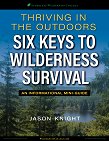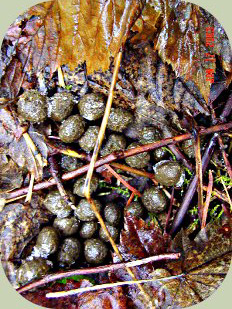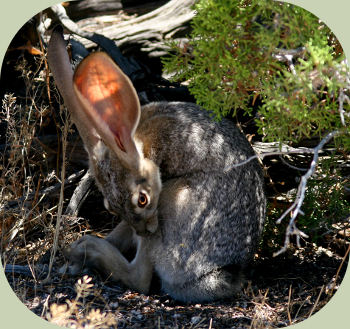Hare and Rabbit Tracks & Sign
An Online Field Guide
Hare and rabbit tracks can be found in many different habitat types, including fields and meadows, riparian areas, woodlands, deserts and even suburban areas. Rabbits and hares eat a variety of vegetable matter including grasses, herbs, fruit and some woody plants.
There are 8 species of cottontail rabbits in North America that live North of Mexico: the brush rabbit, swamp rabbit, marsh rabbit, Eastern cottontail, New England cottontail, Appalachian cottontail, mountain cottontail, and desert cottontail. The 2 most wide spread species in USA are the desert cottontail (Sylvilagus audubonii) and the Eastern cottontail (Sylvilagus floridanus).
Meanwhile, there are 8 species of hares (Lepus spp.) in North America that live North of Mexico including: Snowshoe hare, Alaskan hare, Arctic hare, white-tailed jackrabbit, black-tailed jackrabbit, white-sided jackrabbit, antelope jackrabbit and european hare. Of the hares, the snowshoe hare(Lepus americanus), white-tailed jackrabbit(Lepus townsendii) and black-tailed jackrabbit(Lepus californicus) species are the most wide-spread.
Hare and Rabbit Tracks:

Tracks: Hare and rabbit footprints are generally oval in shape, with 5 toes on each foot, although only 4 toes show in the tracks of each foot. Both have very furry feet and no exposed pads on their toes, often leaving blurred details in the tracks. The fine, sharp claws on the feet may or may not register. Under some conditions, only the pattern left by the claws will be visible. You can often tell the difference between hare and cottontail tracks by looking at the size relationship between front and hind tracks. In hares, the rear tracks are typically larger than the front tracks (see the photo on the right). In cottontails and other rabbits the size of the fronts and hinds is quite similar (see the photo below).
The front and rear tracks of rabbits can appear very similar, though under certain conditions and in certain substrates, the rear feet can splay outward much further. The tracks appear very asymmetrical in shape, with one toe leading ahead of the others. They have been described as "iron shaped," though
The front tracks of the Eastern cottontail (Sylvilagus floridanus) measure 1-1 & 7/8" long by ¾ - 1 & 3/8" wide. Meanwhile, the rear tracks are 1 & ¼- 3 & ¼" long by 7/8 – 1 & 13/17" wide.
The front tracks of the snowshoe hare(Lepus americanus) measure 1 & 7/8" - 3" long by 1 & 1/8" - 2 & 1/4" wide. While, the rear tracks are 3 & 1/4" - 6" long by 1 & 5/8" - 5" wide.


Gaits: Rabbits and hares generally travel in a bounding gait as they move through a landscape. The distance between a set of tracks in a trail might be a few inches to over several meters or more, depending on speed of travel. Occasionally some rabbits will also walk when exploring an area for short distances.
Be More Prepared For Your Next Outdoor Adventure!

Don't leave without knowing these six essential survival skills. Our free survival mini guide reveals the strategies of:
- Shelter & fire to prevent the number one cause of death
- Obtaining clean water to avoid life-threatening dehydration
- Common wild survival foods and other critical skills!

Hare and Rabbit Sign:

Scat: Rabbit and hare scat is distinctly spherical in shape and small in size. They vary in size from about 3/16-7/16" in diameter for cottontails and 3/8- 11/16" in diameter for hares. Scat is composed of compacted pellets of fibrous plant material.
Similar Tracks: The tracks of squirrels can be confused with rabbits as squirrels also travel with a bounding gait. Squirrels, however, tend to show five toes on the rear feet and four toes on the front feet.
References: Elbroch 2003, Halfpenny 1999, Murie 1954, Rezendes 1999.
Additional Resources:
Brush Rabbit Tracks - Bear Tracker's Pages
Wildlife Tracking Courses at Alderleaf
By the way, when you're out tracking or looking for wild animals, it's important to know how to stay safe in the outdoors, especially if you were to get lost. Right now you can get a free copy of our mini survival guide here, where you'll discover six key strategies for outdoor emergencies, plus often-overlooked survival tips.

About the Author: Filip Tkaczyk is a periodic guest teacher at Alderleaf. He also wrote the field guide Tracks & Sign of Reptiles & Amphibians. Learn more about Filip Tkaczyk.

Return from Rabbit Tracks back to Wildlife Tracking Articles.
Is The Essential Wilderness Survival Skills Course Right for You? Take the "Online Survival Training Readiness" Quiz
See for yourself if this eye-opening course is a good fit for you. It takes just a few minutes! Get your Survival Training Readiness Score Now!

Grow Your Outdoor Skills! Get monthly updates on new wilderness skills, upcoming courses, and special opportunities. Join the free Alderleaf eNews and as a welcome gift you'll get a copy of our Mini Survival Guide.

 The Six Keys to Survival: Get a free copy of our survival mini-guide and monthly tips!
The Six Keys to Survival: Get a free copy of our survival mini-guide and monthly tips!
Learn more